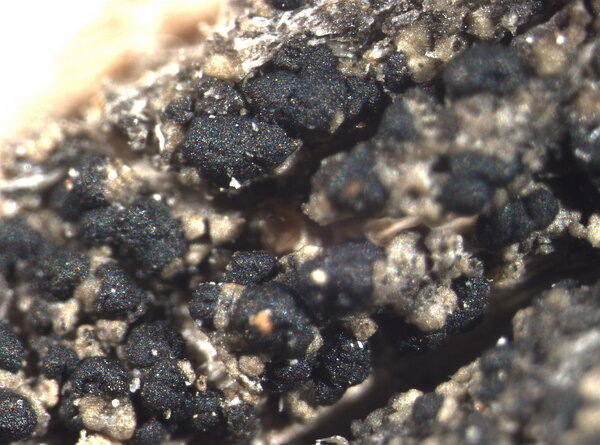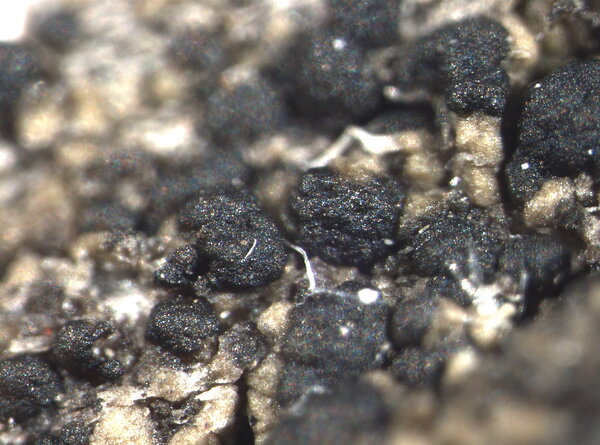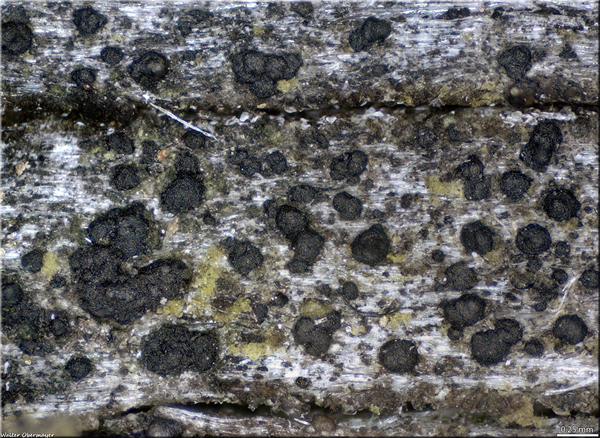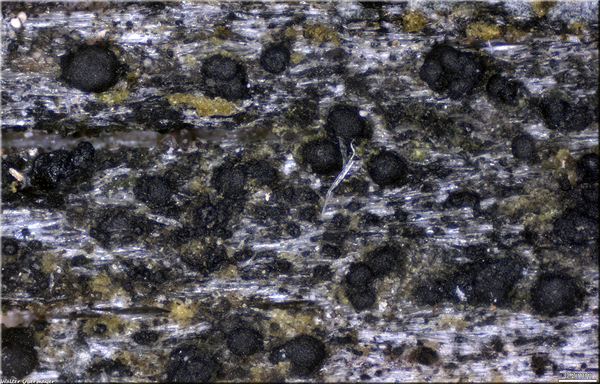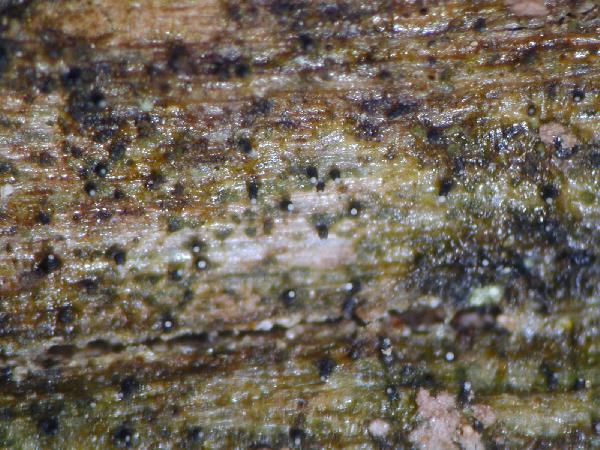Micarea misella (Nyl.) Hedl.
Bih. K. Svenska Vetensk.-Akad. Handl., 3, 18: 78, 88, 1892. Basionym: Lecidea anomala f. misella Nyl. - Lichenes Scand.: 202, 1861.
Synonyms: Biatora misella (Nyl.) H.G. Falk; Lecidea asserculorum sensu Th. Fr. non Ach.; Lecidea asserculorum var. intermedia B. de Lesd.; Lecidea globularis (Nyl.) Lamy; Lecidea misella (Nyl.) Nyl.; Micarea globularis (Nyl.) Hedl.
Distribution: N - Frl, TAA (Thor & Nascimbene 2007, Nascimbene & al. 2007b, 2008c, 2022), Lomb, Lig. C - Tosc (Ravera & al. 2016, Fačkovcová & al. 2024), Abr (Nimis & Tretiach 1999), Sar. S - Bas (Puntillo & al. 2012), Cal (Puntillo 1996).
Description: Thallus crustose, usually endosubstratic and poorly evident, sometimes thinly episubstratic, subgelatinous when wet, consisting of white to pale green-grey, ecorticate, convex granules. Apothecia micareoid, black, grey-black or black-brown (rarely pale in shade-forms), sessile, sometimes almost stalked, 0.1-0.3(-0.4) mm across, sometimes aggregated into tuberculate, up to 0.6 mm wide clusters, with a strongly convex, epruinose disc, without a distinct proper margin. Proper exciple thin, dark brown, K+ violet, of very narrow (<1 µm), radiating, branched and anastomosing, paraphysis-like hyphae; epithecium dull olive, dark olive-grey or olive-brown, K+ violet, C+ red-violet, N-; hymenium colourless or greenish in upper part, 25-45---µm high; paraphyses scarce, sparingly branched except near apices, (0.5-)1-1.2(-1.5) μm thick at mid-level, the apical cells c. 1.5(-1.8) µm wide; hypothecium colourless and K-, or pale green and K+ violet, 45-70 µm high. Asci 8-spored, clavate to cylindrical-clavate, in K/I with a blue outer layer and apical dome and unstained wall, the dome with an apical cushion. Ascospores 1-celled, rarely some of them 1-septate, hyaline, ovoid to ellipsoid, 6-10 x 2-3.5(-4) µm. Pycnidia of two types: a) numerous, simple, stalked and usually subulate, black, glossy to 0.3 mm tall (including pycnidiophores) often with whitish blobs of mesoconidia or with sometimes gaping ostioles, the walls olive or olive-brown, K+ violet, C+ violet, producing cylindrical mesoconidia measuring 3.5-5(-6.5) x 1.2-1.4(-1.7) μm; b) small, black, immersed, producing narrowly cylindrical microconidia measuring 3.5-6 x c. 0.7 μm. Photobiont micareoid, the cells 4-7 μm wide. Spot tests: thallus K-, C- or C+ faintly red, KC- or KC+ faintly red, P- (reactions best observed in thick microscopic sections). Chemistry: variable amounts of gyrophoric acid in thallus, Sedifolia-grey pigment in apothecia and pycnidia. Note: a cool-temperate to circumboreal-montane species found on rotting wood, more rarely on acid bark; most common in the Alps, but also occurring throughout the Apennines.
Growth form: Crustose
Substrata: bark and lignum
Photobiont: green algae other than Trentepohlia
Reproductive strategy: mainly sexual, or asexual by conidia and thalloconidia
Commonnes-rarity: (info)
Alpine belt: absent
Subalpine belt: rather rare
Oromediterranean belt: absent
Montane belt: rare
Submediterranean belt: extremely rare
Padanian area: absent
Humid submediterranean belt: extremely rare
Humid mediterranean belt: absent
Dry mediterranean belt: absent
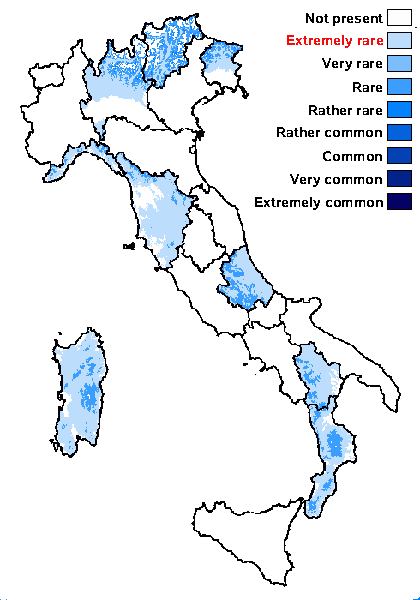
Predictive model
Herbarium samples
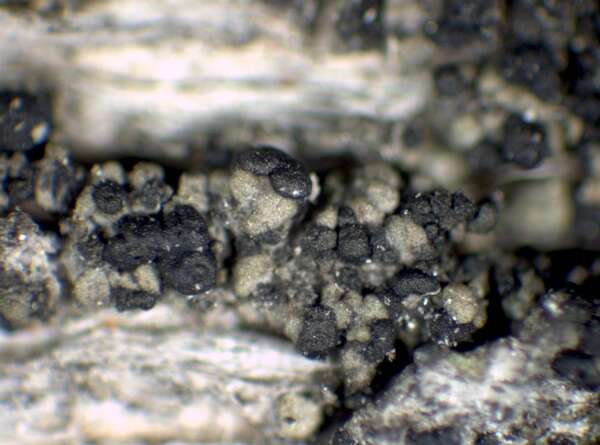

P.L. Nimis; Owner: Department of Life Sciences, University of Trieste
Herbarium: TSB (24295)
2001/11/27


Felix Schumm - CC BY-SA 4.0
[ABL42624], Brazil, Alagoas, Quebrangulo, Pedra Talhada private
area. In in Atlantic rain forest on wooden pale. 9°15’ S, 36°25’35’’ W,
500-700 m. Leg. M. Cáceres & A. Aptroot (no 42624), 21-23.10.2017.
Det. A. Aptroot, 2017. -Hypothecium dark brown.
Growth form: Crustose
Substrata: bark and lignum
Photobiont: green algae other than Trentepohlia
Reproductive strategy: mainly sexual, or asexual by conidia and thalloconidia
Commonnes-rarity: (info)
Alpine belt: absent
Subalpine belt: rather rare
Oromediterranean belt: absent
Montane belt: rare
Submediterranean belt: extremely rare
Padanian area: absent
Humid submediterranean belt: extremely rare
Humid mediterranean belt: absent
Dry mediterranean belt: absent

Predictive model
| Herbarium samples |


P.L. Nimis; Owner: Department of Life Sciences, University of Trieste
Herbarium: TSB (24295)
2001/11/27


 INDEX FUNGORUM
INDEX FUNGORUM
 GBIF
GBIF
 DOLICHENS
DOLICHENS

